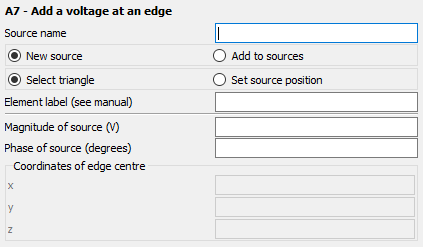A7 Card
This card specifies a voltage source on an edge between two triangles or at a connection between a single triangle and a PEC ground plane or UTD plate.
On the Source/Load tab, in the Sources on
geometry group, click the ![]() Archaic sources
icon. From the drop-down list, click the
Archaic sources
icon. From the drop-down list, click the ![]() Voltage between triangles (A7) icon.
Voltage between triangles (A7) icon.

Figure 1. The A7 - Add a voltage at an edge dialog.
Parameters:
- New source
- A new excitation is defined which replaces all previously defined excitations.
- Add to sources
- A new excitation is defined which is added to the previously defined excitations.
- Select triangle
- If this item is selected, a triangle with label specified in the Element label (see manual) text box is searched for. The excitation is placed on the edge positioned opposite the first corner of the triangle. The label must be unique (if possible only one triangle must have this label). If there is more than one triangle with this label then only a single triangle will be fed. Alternatively, when selecting the option, Set source position, the feeding edge is determined by specifying its Cartesian coordinates in the Coordinates of edge centre group. These coordinates are in meters and optionally scaled by the SF card. The edge must be positioned between two triangles or between a triangle and a ground plane or UTD plate.
- Magnitude of source (V)
- Absolute value of the voltage source in V.
- Phase of source (degrees)
- Phase of the voltage source in degrees.
In selected special cases there may be only one triangle connected to the edge. If the edge is positioned in the plane of a polygonal plate or a PEC ground plane (specified with a GF or BO card), the excitation is placed on the appropriate basis function connecting the triangle to the plate/plane. The positive feed direction is then towards the edge.